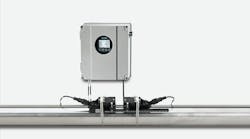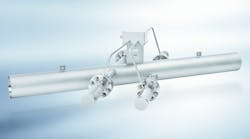There are two main types of ultrasonic flowmeters – transit-time and Doppler. A transit-time ultrasonic flowmeter has both a sender and a receiver. It sends two ultrasonic signals across a pipe at an angle – one with the flow and one against the flow. The meter then measures the “transit time” of each signal. When the ultrasonic signal travels with the flow, it travels faster than when it travels against the flow. The difference between the two transit times is proportional to flowrate.
Many technological improvements have been made in ultrasonic flowmeters over the past 20 years. Because of improvements in electronic processing technology, transit-time meters are better able to handle fluids that are not completely clean. This has enabled transit-time flowmeters to be used for applications that could previously only be handled by Doppler flowmeters. These improvements have also increased the accuracy of ultrasonic meters, which has led to broader use of these meters in a wider variety of conditions.
Another important technological improvement has been the development of multi-path transit-time flowmeters, which use more than one ultrasonic signal or “path” in calculating flowrate. Each path requires a pair of sending and receiving transducers. By using more than one path, the flowmeter measures flow at more than one location in the flowstream, leading to greater accuracy.
Multipath flowmeters have been particularly important in the use of transit-time meters to measure natural gas flow. Suppliers such as Daniel, Instromet, and FMC Energy Systems have introduced four-path, five-path, and six-path transit-time meters, respectively, to measure natural gas flow. In June 1998, the American Gas Association approved the use of multipath ultrasonic flowmeters for custody-transfer natural gas applications. Since that time, there has been a substantial increase in the use of these meters for natural gas measurement, especially for custody transfer.

